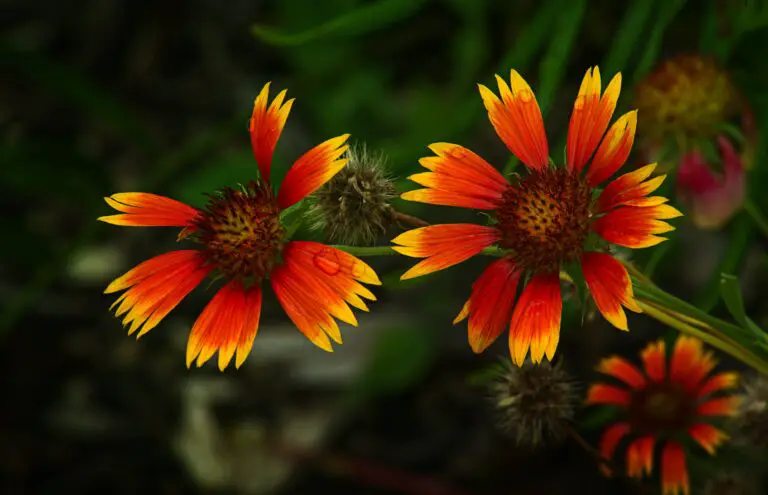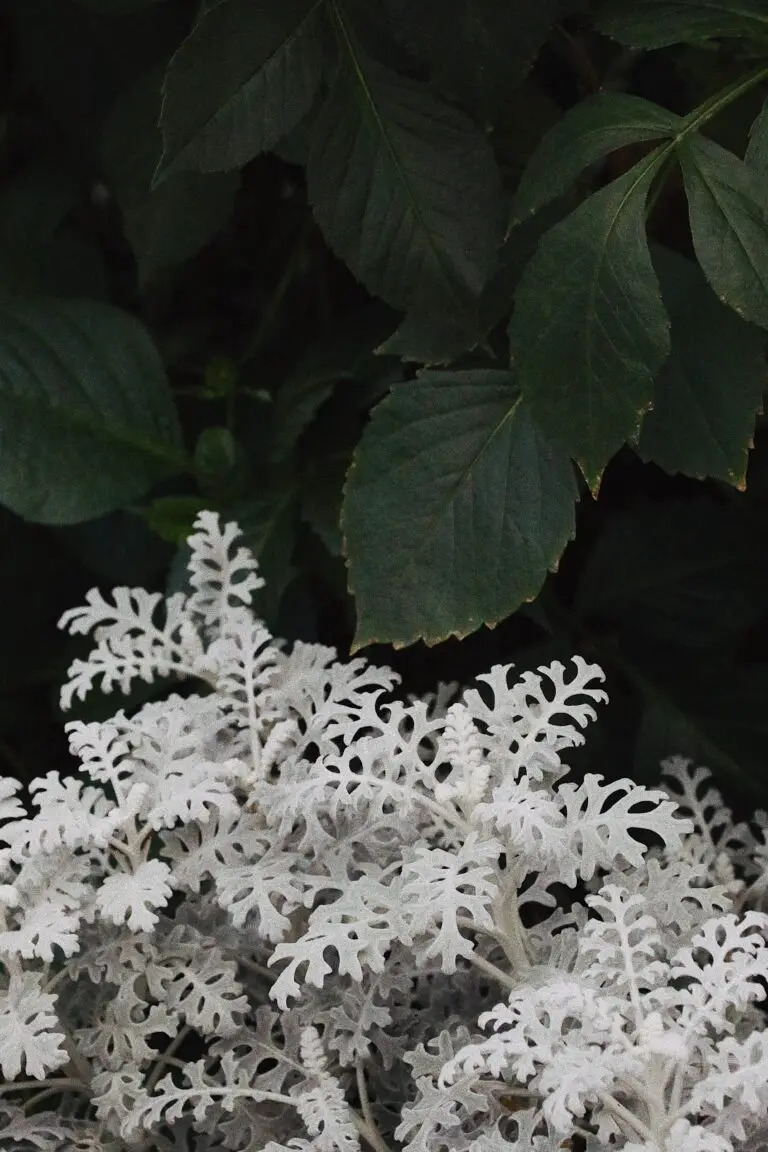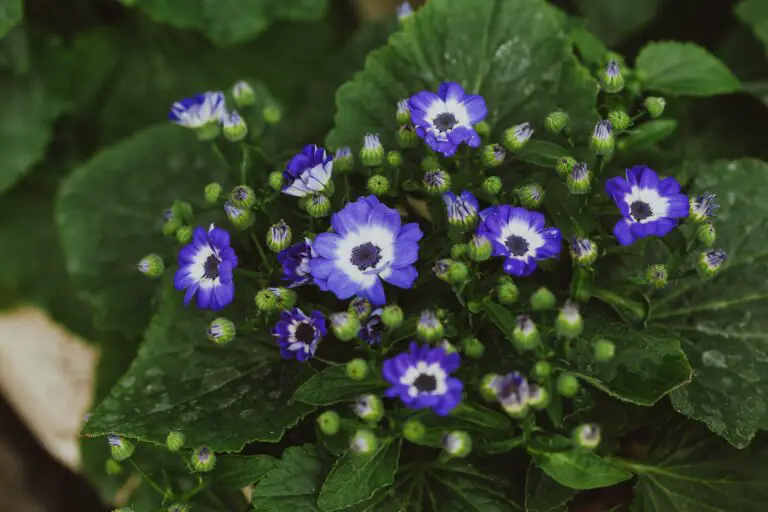Introduction to Senecio Cineraria
Envision a plant that turns your garden into a canvas painted with splashes of silver and textured leaves – welcome to the world of Senecio cineraria, also known as Silver Dust. This striking plant’s ability to add a touch of sophistication to the garden scene comes from its origins, robust nature, and versatile aesthetics. Often referred to by its various names – Silver Ragwort or Dusty Miller – Senecio cineraria has risen in the ranks of garden specialty for its ornamental charm and the ease with which it complements other blooms.
Senecio cineraria hails from the Mediterranean’s rocky coasts, flourishing in the wild, exhibiting resilience and an ability to thrive with minimal fuss. Gardeners prize this stalwart beauty for its unique foliage – the leaves, lacy and soft to the touch, present a striking silver-grey hue that shimmers in the sunlight. It’s as if every leaf is dusted with moonlight, offering a mystical quality to its surroundings.
Imagine stepping into a garden where the hues of golden sunflowers and the brilliant blues of hydrangeas are gently contrasted by the serene silver of Senecio cineraria. This is not mere fantasy; it’s the allure that ‘Silver Dust’ brings to real-life gardens. It’s not just about the color; it’s about texture and contrast too, the way the felted leaves provide a tactile experience that invites curiosity and admiration.
Whether used as a bedding plant to create a silver blanket beneath a canopy of taller species or as a border to define garden paths, Senecio cineraria offers endless possibilities in garden design. Let’s not forget container gardening, where Silver Dust can truly stand out, bringing a spot of perennial allure to patio arrangements and balcony gardens.

Right from the breezy coastlines of its Mediterranean home to the heart of your garden, Senecio cineraria is more than just a plant. It’s a testament to the diversity and adaptability of nature – a low maintenance, high-impact element that enriches garden aesthetics wholesomely. As we delve deeper into understanding the roles it plays within the garden ecosystem, its simplicity juxtaposed with striking beauty stands as a reminder of the effortless elegance nature can offer to our daily lives.
Botanical Profile
Let’s get acquainted with the remarkable Senecio Cineraria, commonly known as Silver Dust. It’s not only its silvery foliage that makes it a showstopper in the garden, but an intriguing botanical background that captures the interest of plant enthusiasts and gardeners alike.
Scientific Classification
Classified within the larger family of Asteraceae, Silver Dust tells a story of resilience and adaptability. Its lineage speaks volumes about its mighty ancestors, which have colonized habitats far and wide with their daisy-like flowers and impressive survival tactics. This little gem is not just a pretty face; it’s akin to botanical royalty with its family tree tracing back to ancient and widespread lineages.
Habitat Explored
The natural habitat of Senecio Cineraria is as captivating as its appearance. Native to the Mediterranean region, this plant has accustomed itself to sunny spots and well-drained soils. In the wild, it garnishes rocky landscapes, an excellent background that complements its shimmering leaves. It’s easy to imagine how this plant’s stunning silver foliage would stand out against the rustic tones of Mediterranean cliffs.
Life Cycle and Growth
Understanding the life cycle of Silver Dust gives us a glimpse into its enduring nature. Most garden specimens are biennials. In its first year, expect a ground show of foliage, with the second year bringing forth its flowers—tiny yellow blooms that crown the foliage, adding a contrasting dash of color.
For those visual learners among us, this video provides a clear window into the growth and care for Silver Dust. Watching this visual guide can be a game-changer for novice and expert gardeners looking to perfect their cultivation techniques.
Mirroring the plant’s adaptive nature, we too can adapt our garden practices to best support the growth and vibrancy of Silver Dust. A comprehensive care guide will gear any green thumb with the knowledge to see this plant flourish season after season.
Engage further with the world of succulents by discovering unique varieties and care tips on our Prickly Petals homepage, your go-to source for all things succulent and more.
Learning about Senecio Cineraria‘s botanical profile opens the door to a deeper appreciation for its role in our gardens. From silver leaves that catch the morning dew to enduring the changing seasons, Silver Dust teaches us the beauty of adaptability and the rewards of meticulous care.
Aesthetic Appeal
Let’s talk about a silver lining that genuinely stands out in the garden – Senecio cineraria, also known as Silver Dust. Much like a touch of moonlight on a dark night, the unique silver foliage of Senecio cineraria provides an ethereal quality to any garden space. The plant’s stark, yet stunning, silver-grey leaves act as a natural spotlight, drawing the eye and creating a visual breather amidst the more common greens.
When it comes to garden design, think of Silver Dust as your secret ingredient for crafting a striking tableau. The silvery sheen of its leaves pairs exquisitely with vibrant flowers, adding contrast that both complements and elevates the visual appeal. Imagine a backdrop of Silver Dust against the fiery reds of geraniums or the deep purples of salvia – it’s not just planting, it’s painting with nature’s palette.
But it’s not all about looks with this versatile plant. Senecio cineraria has a knack for contrast planting, where it excels in bringing out the best in its neighboring flora. The plant’s foliage offers a restful neutrality that makes neighboring flowers pop, ensuring that your garden’s blossoms are never overlooked. For those keen on crafting a garden that commands attention, incorporating this silver-foliaged gem is a smart move.
Incorporating Senecio cineraria into your garden isn’t just about aesthetics; it’s about creating moments of visual poetry. To see this in action, check out this guide for tips on integrating Silver Dust into your succulent arrangements for a mesmerizing effect.
For a real-life example of Silver Dust’s versatility, imagine a coastal-inspired garden where its foliage mirrors the hues of a cloudy seaside – it effortlessly brings a tranquil, beachy vibe right to your doorstep. It’s no wonder Silver Dust is a darling in modern landscape architecture; it’s a living sculpture that enhances the canvas of your garden.
Keen to see how Silver Dust weaves its magic in garden compositions? Feast your eyes on this video showcasing various design approaches:
So next time you’re looking to upgrade your garden’s aesthetic, remember the silver-leafed wonder that is Senecio cineraria. It’s not just a plant; it’s an artist’s stroke that turns your garden into a living, breathing masterpiece.
Ideal Growing Conditions
Let’s talk about creating the perfect slice of paradise for Senecio cineraria, commonly known as Silver Dust. Like any esteemed guest, this silvery-foliaged beauty has some specific requests for its accommodations in your garden. But don’t worry; meeting these requests is a snap, and the mesmerizing display of Silver Dust’s foliage is well worth the effort!
First and foremost, soil is the bedrock of health for these plants. Silver Dust craves well-draining soil that’s like a comfortable bed: not too hard, not too soft, just right. It’s the Goldilocks of garden soil they’re after, where water can slip away easily, not pooling around roots that desperately crave oxygen.
Think of sunlight as the VIP invitation to the grand ball for Silver Dust. Full sun to partial shade is the RSVP these plants are looking for, with a sweet spot of about 6 hours of sunlight per day. They’re like that chilled-out friend who loves the spotlight but can also hang back in the shadows—a flexibility that’s a real boon for garden planning.
Climate is the last piece of the puzzle. Silver Dust, originating from the Mediterranean, enjoys a climate that’s not too extreme. Mild winters and warm summers are the jam of Senecio cineraria. But even if you’re not in Tuscany, don’t fret; the plant can handle a range! Just avoid those freezing temperatures; think of Silver Dust as preferring a light jacket rather than a full-blown parka.
Here’s a pro tip: To see Silver Dust other than in snapshots, embrace mulching. It’s like throwing a protective arm around your plant, keeping its roots cozy and moisture consistent. If you’re interested in companion planting, imagine partnering Silver Dust with vibrant flowers like salvia or marigolds, which you can learn more about in our guide to various succulent types.
So there you have it, the royal treatment for Silver Dust. With the right soil, the kiss of sunlight, and a climate that doesn’t give it the cold shoulder, you’ll have a standout character in your garden that draws everyone’s gaze.
Plant Care and Maintenance
When it comes to invigorating your garden with hints of silver, Senecio cineraria, commonly known as Silver Dust, is your go-to foliage wonder. But to keep this lustrous beauty thriving, a bit of TLC is in order. Fear not, green thumbs and novices alike, for I have some easy-to-follow tips that will ensure your Silver Dust plants stay as sparkling as the morning dew.
Water Wisdom
Imagine a Mediterranean climate—this is the natural habitat for the glamorous Silver Dust. It’s all about balance: not too much, not too dry. Stick your finger about an inch into the soil; if it feels like a well-wrung sponge, hold off on the watering can. If it’s drier than a summer day in Sicily, it’s time to quench its thirst. The goal is to mimic natural weather patterns, so adjusting your watering rhythm with the seasons is key to keeping this silvery spectacle in top form.
Fertilizing Fundamentals
Just as we relish a nutritious meal, your Silver Dust deserves a regular dose of goodness. Once a month during the growing season, treat them to a balanced, water-soluble fertilizer. A 10-10-10 blend does wonders, encouraging robust growth. Think of it as a monthly spa day for your plants—essential for maintaining their vigor and health.
Pruning Practices
Silver Dust is known for its bushy demeanor, which we adore. But every now and then, it needs a trim to encourage fresh, vibrant growth. When you spot a few stems looking a little lackluster, don’t hesitate to give them a snip. It’s like giving your plants a haircut to promote new, healthy foliage. An early spring prune sets the stage for a season of shimmering success.

With just a little bit of know-how and love, your Silver Dust plants will not only survive but thrive, adding a touch of precious metal to your garden palette. So go on—show your plants some care, and they’ll reward you with a display that’s nothing short of spectacular.
Landscape and Companion Planting

Imagine a tapestry of greens in your garden, now insert the striking contrast of Senecio cineraria’s silver foliage, and voilà, you’ve elevated your landscape to a work of art. This plant, commonly known as Silver Dust, acts as a brilliant accent in any garden design. Its unique color and texture make it an ideal choice for breaking the monotony of green and drawing the eye to specific areas.
For example, create a mesmerizing border by lining pathways with the soft, shimmery leaves of Silver Dust. As the sun sets, watch how they seem to catch the last light of day, bringing a gentle glow to the garden. It’s not just about looks; Senecio cineraria grows well in various conditions, making it a versatile player in your horticultural ensemble.
When considering companion plants, opt for companions that complement its cool silver hue yet stand up to the visual punch it packs. The deep purples of lavender or the fiery reds of salvia can create a sizzling contrast. Conversely, planting alongside pastel hues like soft pink roses or pale blue delphiniums yields a more tranquil scene. It’s all about the mood you’re aiming to set!
Nestling Silver Dust amongst evergreens can also spotlight its aesthetic in winter gardens. As the emerald needles offer a year-round backdrop, the silvery leaves become the stars of the chilly season. The naturalistic planting style, using ornamental grasses and perennials in swathes, has become increasingly popular. In such a setting, Senecio cineraria can break the vertical lines with its softer, mounded form.
Whether you’re designing a formal parterre or a laid-back cottage garden, Silver Dust slides right into the narrative, adding that ‘wow’ factor. So, if you haven’t yet, consider inviting Senecio cineraria to your garden party. It’s the guest that gets along with everyone and never fails to impress.
Common Pests and Diseases
Imagine your vibrant Senecio cineraria, also known as Silver Dust, catching the eye of every passerby with its unique silvery foliage. Now imagine those same leaves losing their luster to the relentless nibbling of pests or the creeping invasion of disease! Not on our watch! Let’s suit up and get ready to protect these garden guardians together.
Despite its hardy nature, the Senecio cineraria can fall victim to several common foes. Aphids, those pesky little sap-suckers, adore the underside of the leaves. Look out for the sticky residue they leave behind called honeydew. It can lead to sooty mold which not only sounds grim but also blocks precious sunlight. Your best bet? Encourage native predators like ladybugs, or introduce them to your garden for a natural takedown.
Playing Detective With Your Plants
Then there are spider mites, almost invisible to the naked eye but their handiwork isn’t. They create a fine, almost artistic webbing on the underside of the leaves. But art galleries are no place for your Senecio cineraria; it’s meant to shine in your garden! A strong stream of water or an organic miticide can escort these unwanted artists off the premises.
And don’t let powdery mildew cast a dull film over your Silver Dust’s performance. This fungal disease can sweep through like a fog if conditions are moist and lacking in airflow. Your mission is to promote good air circulation and consider a fungicide if you’re dealing with an outbreak. Remember, prevention is your garden’s best armor!
Let’s not forget slugs and snails—garden party crashers that find the silvery leaves particularly gourmet. You might spot slimy trails on the soil or directly on the leaves. But worry not, a little bit of diatomaceous earth or a slug trap can save the day.
To get a visual on some of these garden intruders in action, why not take a peek at this insightful video? It’ll equip you with the knowledge you need to keep your Senecio cineraria shining bright.
Arm yourself with this knowledge, and your Senecio cineraria will thank you with its undiminished silver glow, playing its role in turning your garden into a scene straight out of a fairytale. These silver-foliaged stars are depending on you to keep the pests and diseases at bay, so the show can go on!
Propagation Techniques
Ever dreamt of creating an army of silver warriors without breaking a sweat? Well, in the plant world, it’s completely doable, and Senecio cineraria, commonly known as Silver Dust, is your perfect recruit for this mission. Let’s dive into the leafy trenches and discover the secrets to multiplying your silvery treasure.

Starting From Seeds: The Patient Gardener’s Path
Are you the type that relishes the anticipation of seeing life sprout from the very beginning? Then seed propagation is your match. It’s like watching your favorite series unfold, but in slow motion, and yes, it’s binge-worthy. Start by sowing the Silver Dust seeds in well-drained soil during spring. Keep them warm and moist, like a gentle Mediterranean breeze, and soon, tiny sprouts will waltz their way up to the dance floor of your garden.
Cuttings: For Those Who Can’t Wait to Tango
If patience isn’t your strong suit and you’re itching for immediate action, cuttings are your go-to. It’s the horticultural equivalent of a flash mob—quick and sensational. Select a healthy, non-flowering shoot in the late spring or early summer. Then, with the precision of a seasoned gardener, snip a 3-4 inch piece and dip the end into rooting hormone (that’s the secret salsa move). Plant it in moist soil and cover with plastic to keep the humidity equivalent to a tropical getaway. In a few weeks, roots will emerge, ready to join the party in your silver-themed garden.
Remember, whether you choose the path of the seed or the swift cut of a cutting, both journeys promise a reward of shimmery foliage that breathes life into every corner of your garden. So don your gloves, brandish your trowel, and may your Silver Dust troops thrive!
Environmental Impact of Senecio Cineraria in Sustainable Gardens
In the world of sustainable gardening, every plant plays a pivotal role, and Senecio cineraria, commonly known as “Silver Dust,” is a star performer. This dazzling silver-foliaged plant is more than just a pretty face in the garden; it’s a testament to resiliency and environmental friendliness. Let’s dig a little deeper into the non-invasive nature of this silver gem.
Picture this: a garden that requires minimal watering, resists local pests naturally, and thrives in the heat of summer without a wilted leaf in sight. That’s the magic of including drought-tolerant plants like Senecio cineraria in your eco-friendly oasis. Unlike some of its invasive relatives that can wreak havoc on local ecosystems, Silver Dust stays put, playing nicely with neighboring flora and fauna.
Why Silver Dust is a Green-Thumb’s Dream
Imagine the peace of mind that comes with planting species that won’t escape your garden and harm native plant communities. That’s the peace Senecio cineraria offers. Its non-invasive roots keep it anchored where you plant it, allowing gardeners to design with precision and care for native biodiversity.
Let’s put it in real terms. Consider the local park that once battled invasive species, gobbling up resources and choking out the natives. Now, replace that with clumps of Silver Dust, coexisting harmoniously and requiring zero herbicides. Not only does this reduce chemical use, but it also paints a serene picture of what sustainable gardening can look like when we choose our plants wisely.
And it’s not just about what doesn’t happen with Senecio cineraria; it’s about what does. This hardy perennial brings a much-welcomed reprieve to water bills and maintenance time. It’s like hiring an expert gardener who asks for nothing in return but a spot in the sun.
So, next time you’re considering a new addition to your drought-resistant landscape, remember the subtle yet significant impact of Silver Dust. It’s a garden ally, helping you craft the picturesque, low-maintenance, and sustainable space of your dreams.
Interested in seeing how this plant performs in real life? Watch this informative video for visual inspiration on integrating Senecio cineraria into your sustainable garden!
Frequently Asked Questions
Are you curious about the silvery foliage that twinkles in your garden? That’s Senecio cineraria, commonly known as ‘Silver Dust’. It sparkles like a constellation among your garden greens. But, as with any standout plant, a flurry of questions often follows. Let’s dig in and unearth answers to the queries tickling the minds of many garden enthusiasts!

Is Senecio cineraria toxic to my furry companions?
First things first, pet owners take note: Senecio cineraria harbors a secret beneath its lustrous leaves. Yes, it’s true, the plant can be toxic if ingested by your pets. Cats or dogs nibbling out of curiosity might end up with an upset stomach or more severe symptoms. Always practice caution and place Silver Dust out of paw’s reach.
Sharing the warmth: Tips for overwintering Silver Dust
If your garden is draped in snow more often than not, you might wonder how to keep your Silver Dust shimmering through the frost. The key is overwintering! Think of it as giving your plant a cozy blanket and a warm cup of cocoa. Although not fond of extreme cold, Senecio cineraria can survive winter with some protective measures. Keep it in a pot and bring it indoors to a sunny spot. With reduced watering and no fertilizer, your Silver Dust will hibernate happily until spring.
Real-life tips from a gardener’s journal
Don’t just take my word for it; let’s peek into the diary of a seasoned gardener. “Last winter, I tucked my Silver Dust in my sunroom, and it was like they never noticed the winter chill,” they wrote. “Come spring, I eased them back outside, and they were more vibrant than ever!” Real-life experiences like these offer a glimpse into successful Silver Dust parenting.
Stumped by your Silver Dust? Don’t be!
Maybe it’s the Silver Dust’s alluring charm that stirs such curiosity. But with these insights, you’re now equipped to keep your Senecio cineraria thriving—and your pets safe—all year round. Keep those questions coming and watch your garden blossom into a silvery sanctuary!



